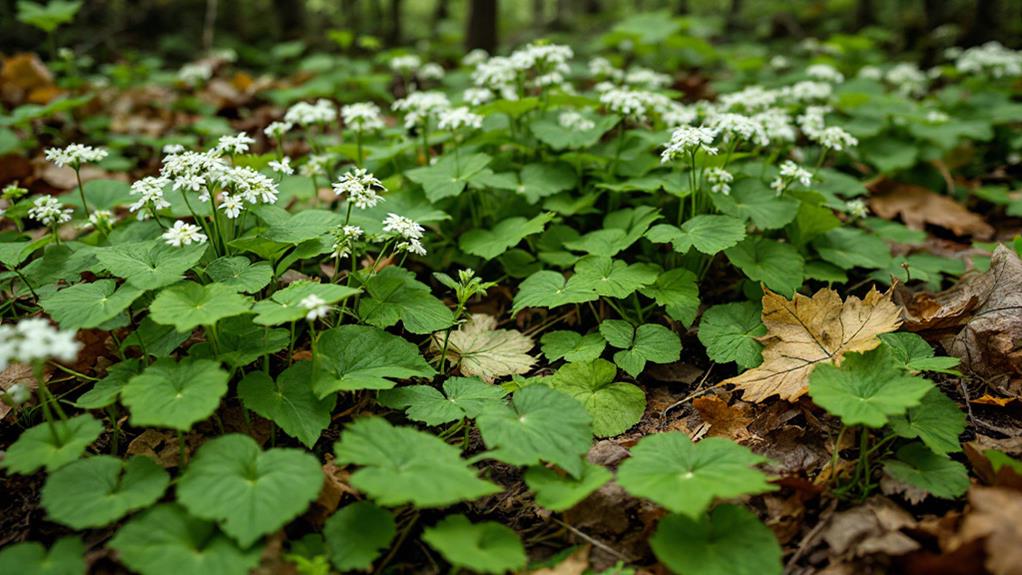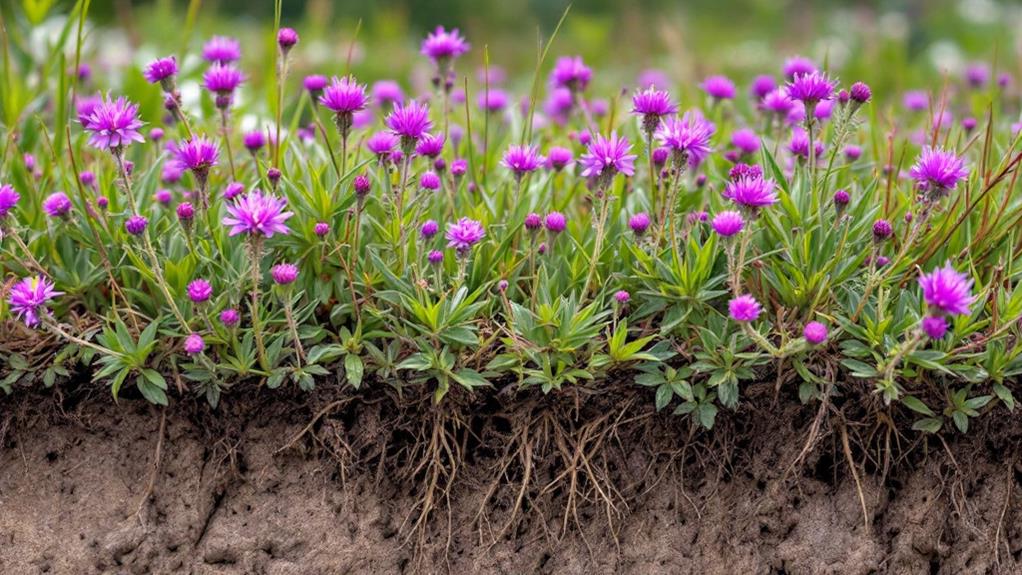You'll encounter allelopathy in various plants, from trees to crops and invasive species. Black walnut trees release juglone, inhibiting nearby plants, while eucalyptus trees use volatile oils to dominate ecosystems. Crops like sorghum, alfalfa, and barley produce compounds that suppress weeds. Some rice varieties have been bred for allelopathic traits to reduce herbicide use. Invasive species like garlic mustard and spotted knapweed disrupt native ecosystems through chemical warfare. Pines and firs also exhibit strong allelopathic effects in forests. Understanding these interactions is essential for agriculture, forestry, and conservation. Dig deeper to uncover the fascinating world of plant chemical communication.
Black Walnut Tree

The black walnut tree is one of the most well-known examples of allelopathy in action. You'll find this North American native producing a chemical called juglone, which it uses to suppress the growth of competing plants. This powerful compound is present in all parts of the tree, including its roots, leaves, and fruit husks.
When you observe the area around a black walnut tree, you'll notice a distinct lack of plant diversity. Many species simply can't tolerate juglone and will wither or die if they try to grow too close. Some particularly sensitive plants include tomatoes, potatoes, apples, and pines. However, you'll find that certain plants have evolved to withstand juglone's effects, such as some grasses, violets, and even other black walnuts.
You might wonder how juglone spreads through the soil. It's primarily released through the tree's root system and when rain washes it from fallen leaves and decaying husks. The compound can persist in the soil for several months, creating a long-lasting zone of inhibition around the tree.
If you're a gardener or farmer, you'll need to be aware of the black walnut's allelopathic effects. It's essential to plan your plantings carefully if you have these trees on your property. You can mitigate some of the effects by using raised beds or containers for sensitive plants, ensuring proper drainage, and regularly removing fallen leaves and nuts from the area.
Eucalyptus Trees
Among the most notorious allelopathic plants, eucalyptus trees stand out for their potent chemical warfare against competing vegetation. These Australian natives have evolved to dominate their environment by releasing toxic compounds that inhibit the growth of other plants. You'll find that eucalyptus trees employ a multi-pronged approach to suppress their competition.
Eucalyptus leaves contain volatile oils rich in compounds like cineole and eucalyptol. When these leaves fall and decompose, they release these chemicals into the soil. The oils can persist in the ground for months, creating a hostile environment for other plant species. You'll notice that the area beneath a eucalyptus tree is often barren, with little to no understory vegetation.
The tree's roots also play a role in this chemical warfare. They exude allelopathic substances directly into the soil, further inhibiting seed germination and root growth of nearby plants. This strategy allows eucalyptus trees to monopolize water and nutrients in their immediate vicinity.
Even the tree's bark contributes to its allelopathic effects. As it sheds, the bark releases additional growth-inhibiting compounds into the surrounding area. You'll observe that this thorough approach makes eucalyptus trees formidable competitors in any ecosystem they inhabit.
The allelopathic properties of eucalyptus have significant ecological implications. When introduced to new environments, these trees can quickly outcompete native vegetation, leading to reduced biodiversity. You should be aware that planting eucalyptus in your garden might negatively impact other plants, as their allelopathic effects can extend well beyond their immediate growing area.
Sunflowers

Surprisingly, sunflowers also exhibit allelopathic properties, though they're not as aggressive as eucalyptus trees. These cheerful, towering plants produce chemicals that can inhibit the growth of certain other plants in their vicinity. The main allelopathic compounds found in sunflowers are phenolic acids and terpenes, which are released through their roots and leaf litter.
You'll notice that sunflowers can suppress the growth of weeds around them, making them a useful tool in organic gardening. They're particularly effective against broad-leaved weeds and some grasses. This natural weed control can be beneficial if you're looking to reduce herbicide use in your garden or farm.
However, sunflowers' allelopathic effects aren't limited to weeds. They can also impact the growth of certain crops. If you're planning to grow sunflowers in rotation with other crops, you should be aware that they might affect the yield of subsequent plantings. Crops like peas, beans, and soybeans can be particularly sensitive to sunflower residues in the soil.
To mitigate these effects, you can implement crop rotation strategies. Allow sufficient time between sunflower cultivation and planting sensitive crops. Alternatively, you can use sunflowers as a cover crop or green manure, incorporating their residues into the soil to improve its structure and fertility.
While sunflowers' allelopathic properties can be a double-edged sword, understanding and managing them can help you harness their benefits while minimizing potential drawbacks in your agricultural or gardening practices.
Allelopathic Rice Varieties
Several rice varieties have been identified with allelopathic properties, making them valuable tools in sustainable agriculture. These rice varieties can suppress weed growth naturally, reducing the need for chemical herbicides and improving crop yields. You'll find that some of the most notable allelopathic rice varieties include PI 312777, Taichung Native 1, and IR64.
When you grow allelopathic rice, you're taking advantage of its ability to release chemical compounds that inhibit the growth of competing plants. These compounds, known as allelochemicals, can affect weed seed germination, root development, and overall plant growth. You'll notice that fields planted with allelopathic rice varieties often have fewer weeds and require less manual or chemical weed control.
If you're considering using allelopathic rice in your farming practices, you should know that the effectiveness can vary depending on environmental conditions and the specific weed species present. You'll need to select the right variety for your region and carefully manage your crop to maximize its allelopathic potential.
Research has shown that allelopathic rice varieties can reduce weed biomass by up to 40% compared to non-allelopathic varieties. You'll find this particularly useful in organic farming systems or in areas where herbicide resistance is a concern. By incorporating allelopathic rice into your crop rotation, you're not only controlling weeds but also potentially improving soil health and reducing your environmental impact.
As you explore allelopathic rice varieties, you'll discover that ongoing research is focused on enhancing these traits through breeding programs and identifying new allelopathic compounds. This research promises to provide even more effective and sustainable weed management options for rice farmers in the future.
Garlic Mustard

Garlic mustard (Alliaria petiolata) stands out as a prime example of allelopathy in invasive plant species. This biennial herb, native to Europe and Asia, has become a significant ecological threat in North American forests. When you encounter garlic mustard in the wild, you're witnessing a plant that's mastered the art of chemical warfare against its neighbors.
The allelopathic effects of garlic mustard are multifaceted. It produces a range of compounds, including glucosinolates and cyanide, which inhibit the growth of other plants and disrupt beneficial mycorrhizal associations in the soil. You'll notice that areas invaded by garlic mustard often have reduced native plant diversity and altered forest floor compositions.
What makes garlic mustard particularly effective is its ability to target multiple aspects of the ecosystem. It doesn't just suppress competing plants; it also affects soil chemistry and microbial communities. When you walk through a garlic mustard-infested area, you're treading on soil that's been biochemically altered to favor this invader.
The plant's allelopathic strategy is so potent that it can even affect tree seedlings, potentially altering the future composition of forests. You'll find that in heavily invaded areas, native tree regeneration is often compromised. This long-term impact makes garlic mustard a significant concern for forest managers and conservationists.
Control efforts for garlic mustard are challenging due to its allelopathic legacy. Even after removing the plants, the soil may remain inhospitable to native species for some time. When you're involved in restoration efforts, you'll need to take into account this lingering effect in your planning.
Sorghum
While garlic mustard showcases allelopathy in invasive species, sorghum demonstrates how cultivated crops can employ similar chemical tactics. Sorghum, a major cereal crop grown worldwide, produces a potent allelochemical called sorgoleone. This compound exudes from the plant's roots and inhibits the growth of nearby competing plants.
You'll find that sorgoleone is particularly effective against small-seeded weeds, giving sorghum a competitive edge in the field. It works by interfering with photosynthesis and cellular respiration in susceptible plants, stunting their growth or preventing germination altogether. This natural weed control mechanism has attracted significant interest from agricultural researchers and farmers alike.
The allelopathic effects of sorghum aren't limited to its living plants. Even after harvest, sorghum residues left in the field continue to release allelochemicals, suppressing weed growth in subsequent crops. This property has led to the use of sorghum in crop rotation and as a cover crop to manage weeds naturally.
However, you should be aware that sorghum's allelopathy can be a double-edged sword. While it helps control weeds, it may also negatively impact the growth of desirable crops planted in rotation with sorghum. Crops like soybeans and wheat can suffer yield reductions when following sorghum in a rotation.
To harness sorghum's allelopathic potential effectively, you'll need to take into account factors such as soil type, climate, and crop selection. By understanding and managing these variables, you can leverage sorghum's natural weed-suppressing abilities to reduce herbicide use and promote sustainable agricultural practices.
Spotted Knapweed

Turning our attention to another invasive species, spotted knapweed presents a formidable example of allelopathy in action. Native to Eastern Europe, this plant has become a significant problem in North America, particularly in the western United States. Spotted knapweed's success as an invader is largely due to its potent allelopathic properties.
You'll find that spotted knapweed produces a chemical compound called catechin, which it releases into the soil through its roots. This compound inhibits the growth and germination of neighboring plants, effectively creating a barren zone around the knapweed. Catechin works by interfering with other plants' ability to absorb nutrients and by triggering a stress response that leads to cell death.
What's particularly interesting about spotted knapweed's allelopathy is its selectivity. While it suppresses many native plant species, it doesn't harm plants that have co-evolved with it in its native range. This gives spotted knapweed a significant advantage in invaded ecosystems, where native plants haven't developed resistance to catechin.
The impact of spotted knapweed's allelopathy extends beyond plant communities. By reducing plant diversity and altering soil chemistry, it can affect entire ecosystems. You'll often see decreased forage for wildlife and livestock, increased soil erosion, and changes in water runoff patterns in areas invaded by spotted knapweed.
Combating spotted knapweed's spread is challenging due to its allelopathic effects. Traditional control methods like herbicides or mechanical removal may not be enough, as the residual catechin in the soil can continue to suppress native plant growth even after the knapweed is gone.
Alfalfa
Many gardeners and farmers are familiar with alfalfa as a nutritious forage crop, but you might not know about its allelopathic properties. Alfalfa (Medicago sativa) produces several compounds that can inhibit the growth of other plants, including saponins, flavonoids, and phenolic acids. These chemicals are released into the soil through root exudation and the decomposition of plant residues.
You'll find that alfalfa's allelopathic effects are particularly strong against certain weeds and crops. It can suppress the growth of annual grasses like barnyard grass and green foxtail, as well as broadleaf weeds such as pigweed and lambsquarters. This natural weed control ability makes alfalfa an attractive option for organic farming systems.
However, alfalfa's allelopathy isn't always beneficial. If you're planning to rotate crops, you should be aware that alfalfa can negatively impact the growth of subsequent crops like corn, wheat, and soybeans. The residual allelopathic compounds in the soil can reduce germination rates and stunt the growth of these plants.
To mitigate these effects, you can implement strategies such as allowing sufficient time between alfalfa and sensitive crops, incorporating cover crops to help break down alfalfa residues, or using tillage to mix and dilute the allelopathic compounds in the soil.
It's worth noting that alfalfa's allelopathic potential can vary depending on factors like cultivar, plant age, and environmental conditions. By understanding these interactions, you can better manage alfalfa in your crop rotations and take advantage of its weed-suppressing abilities while minimizing negative impacts on desired plants.
Barley

Barley, a staple grain crop grown around the world, is known for its allelopathic properties that can impact nearby plants. When you cultivate barley, you're not just growing a nutritious grain; you're also introducing a natural weed suppressor into your field. Barley releases allelopathic compounds, primarily phenolic acids, that can inhibit the growth of competing plants.
These compounds are found in various parts of the barley plant, including its roots, leaves, and straw. As the plant grows and decomposes, it releases these chemicals into the surrounding soil. You'll notice that certain weeds struggle to establish themselves in barley fields due to these allelopathic effects.
Barley's allelopathic potential isn't limited to its growing period. Even after harvest, barley residues left in the field continue to exert allelopathic influence. This makes barley an excellent choice for crop rotation and weed management strategies. You can use barley as a cover crop or incorporate its residues into the soil to suppress weeds in subsequent plantings.
However, it is essential to understand that barley's allelopathic effects aren't universally beneficial. While they can help control weeds, they may also negatively impact some desirable crops. For instance, if you're planning to grow certain legumes or small-seeded crops after barley, you might experience reduced germination or stunted growth.
To maximize the benefits of barley's allelopathy, you should consider integrating it strategically into your crop rotation plan. By doing so, you can harness its weed-suppressing properties while minimizing potential negative impacts on subsequent crops. This approach can help you reduce reliance on chemical herbicides and promote more sustainable farming practices.
Pines and Firs
Several species of pines and firs exhibit strong allelopathic effects in forest ecosystems. You'll find that these coniferous trees release chemical compounds that inhibit the growth of other plants, creating a competitive advantage for themselves. This allelopathic behavior plays an essential role in shaping forest composition and succession.
In pine forests, you'll notice a sparse understory, often attributed to allelopathy. Pines release terpenes and phenolic compounds through their needles, bark, and roots. These chemicals accumulate in the soil, suppressing the germination and growth of competing vegetation. You'll observe this effect particularly in species like Pinus halepensis (Aleppo pine) and Pinus sylvestris (Scots pine).
Firs, such as Abies balsamea (balsam fir), also demonstrate allelopathic properties. They produce compounds like abscisic acid and other phenolics that inhibit seed germination and seedling growth of neighboring plants. You'll see how this helps firs maintain dominance in their ecosystem.
The allelopathic effects of pines and firs aren't limited to the forest floor. You'll find that their leaf litter decomposition releases these chemicals into the soil, creating a long-lasting impact on the surrounding vegetation. This process contributes to the formation of unique plant communities beneath coniferous canopies.
Understanding the allelopathic nature of pines and firs is important for forest management and conservation efforts. You'll need to take these effects into account when planning reforestation projects or managing natural pine and fir stands. By recognizing the role of allelopathy in these ecosystems, you can better predict and manage forest dynamics and biodiversity.

Erzsebet Frey (Eli Frey) is an ecologist and online entrepreneur with a Master of Science in Ecology from the University of Belgrade. Originally from Serbia, she has lived in Sri Lanka since 2017. Eli has worked internationally in countries like Oman, Brazil, Germany, and Sri Lanka. In 2018, she expanded into SEO and blogging, completing courses from UC Davis and Edinburgh. Eli has founded multiple websites focused on biology, ecology, environmental science, sustainable and simple living, and outdoor activities. She enjoys creating nature and simple living videos on YouTube and participates in speleology, diving, and hiking.

